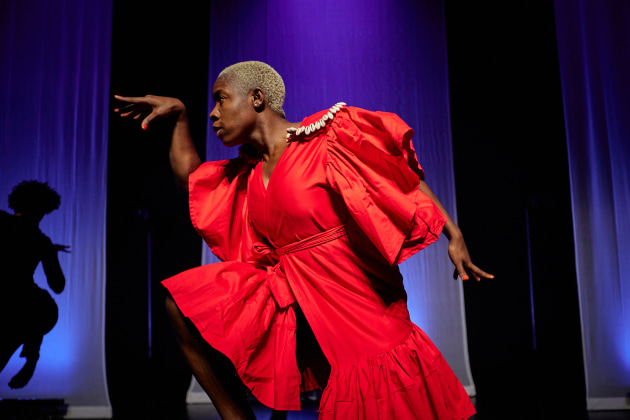REVIEWS: Perth Festival
BIKUTSI 3000
Blick Bassy
Studio Underground, State Theatre Centre, Perth
Reviewed: Saturday, February 11
EQUATIONS OF A FALLING BODY
Laura Boynes
Studio Underground, State Theatre Centre, Perth
Reviewed: Friday, February 24

Created by Blick Bassy, Bikutsi 3000 is an immersive experience of powerful storytelling. The 60-minute performance swings between narration (via a pre-recorded visual projection) and dance breaks, supported by Bassy’s original score of electro-afrobeats. The story, while fictional, educates viewers on the history of Africa and is a celebration of female empowerment.
The narrator, Hermine Yollo (pre-recorded in French and projected with English surtitles), tells a story beginning during the colonisation and division of Africa (“Mintaba”) in the late 1800s. The queen of Mintaba, Queen Ngo Nyaga, opposed the plan of the Western nations to split up her country-continent and, in response, she developed a project of resistance. The project, which she called “Bikutsi 3000”, involved five phases, each lasting 33 years, in which an army of women in each of the five selected regions use dance as the weapon against the destruction of their ancient traditions.
The story unfolds through each phase of the revolution, taking place in Cameroon, Namibia, Togo, Tanzania and Burundi-Rwanda.
The all-female cast, consisting principally of Nadia (“Nadeeya”) Gabrieli Kalati, Martine Mbock, Audrey Carlita and Mwenda Marchand, was thrilling to watch. Each dancer represented one of the appointed captains of the resistance in each region (all four depicting the leader in the final region) with each dancer having developed her own choreography.
The show requires immense stamina from all dancers and on this night the four women certainly delivered. Gabrieli Kalati (representing Cameroon) combined both modern house dance and the traditional Cameroonian dance, Bikutsi (which involved striking the floor with her feet and rhythmically bobbing); she hit every movement at full force and was a great opener for the show. Mbock’s choreography (representing Namibia) primarily consisted of waacking, which was unexpectedly modern. Carlita (representing Togo) had captivating stage presence as she executed choreography layered with elements of dancehall, hip hop and krump. Marchand (representing Tanzania) was a beautiful contrast to the other dancers, offering softer, more fluid choreography that was rooted in both dancehall and contemporary. The choreography overall was a clever accompaniment to the story, as it depicted women supporting each other and enabling each individual to shine in her own way.
Four young, local dancers joined the principal performers for the final segment of the show. It was unfortunately obvious that some of the young artists lacked stage experience and had difficulties with the choreography. However, these dancers were still an asset to the show overall, as they connected the story to the local audience.

WHILE BIKUTSI 3000 offered a clear and linear storyline, Equations of a Falling Body, created by Laura Boynes, is a performance rooted in disorder. In this show, Boynes sits to one side and instructs three dancers (James O’Hara, Ella-Rose Trew and Timothy Green) through earpieces to create numerous, varied scenes of real-time choreography. With the musical score ranging from techno to opera, this piece is often jolting and an attack on the senses.
In the darkness, the rear curtain lifts to reveal a hidden length of stage in which a body (O’Hara) is suspended from the ceiling, floating and spinning. The body is lit only by the headtorches of two other figures (Trew and Green). Once the body is lowered into a shallow pool of water, it begins to roll and emerge from the darkness. Visually striking, this was an exciting and provoking way to start the show.
The show concludes with an equally striking scene. The three dancers hold disposable coverall suits against a large fan, with the suits lit by the dancers’ headtorches. As they let the suits go, the suits fly away and softly land, skidding across the stage. The limbs of the suits flail randomly to create a hauntingly beautiful image of bodies falling.
The remainder of the show, however, was somewhat underwhelming. Most of the dramatic, dark scenes are cut by white lights snapping on and the dancers packing up their props to prepare for the next scene. While this is clearly a creative choice to be deliberately jolting, it interrupted the flow of the performance and became uninteresting by the third or fourth time. Similarly, the performance is peppered with humour, but the jokes were often repetitive and quickly became stale.
The dancers themselves, however, were impressive. The choreography involved protracted, liquid movements, and all three performers demonstrated great strength and control in its execution. The dancers were often required to clamber awkwardly on top of each other, and I enjoyed seeing the intense trust between them.
While the premise of the show is bold, the overall presentation was unfortunately disjointed. It was regrettable to see a piece with so much promise only reach snippets of excellence.
Nevertheless, both Bikutsi 3000 and Equations of a Falling Body signal a fresh and diverse season for Perth Festival.
– ALANA KILDEA
Stay up to date with news and reviews! Subscribe to our e-news: just go to our homepage and click the Newsletter Signup box. It's free!


